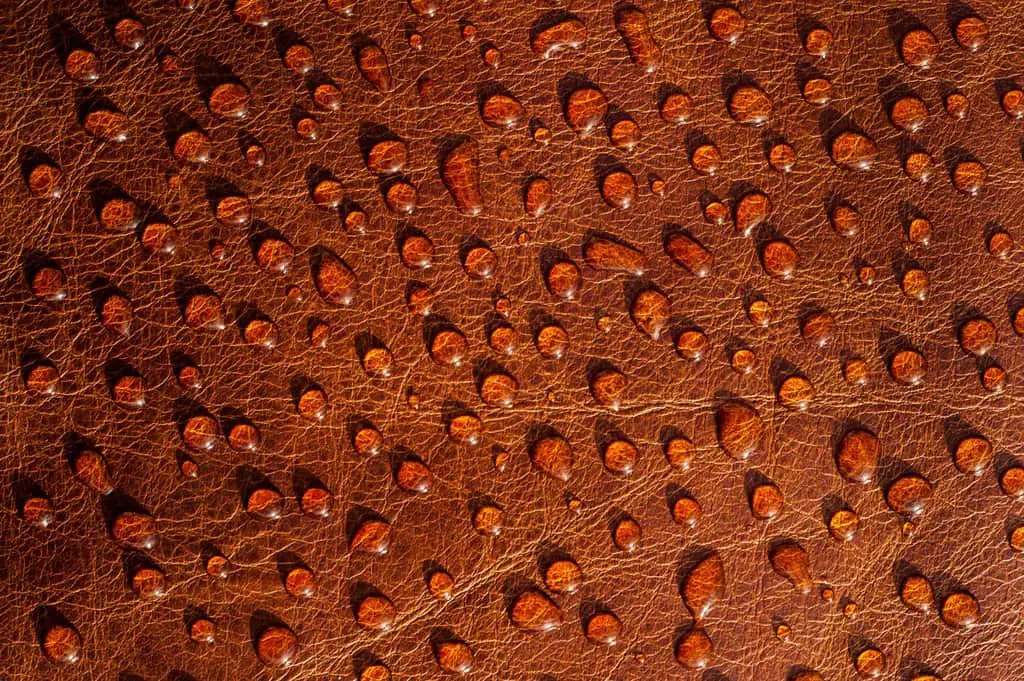Leather is one of the most fragile materials when faced with the risk of getting wet. Different types of leather will react to liquid substances differently and it’s important you know how to fix it if you accidentally get them wet. In this article, we’ll be discussing the risks of getting your leather wet, the possible negative effects, and how you can mitigate the damage as soon as possible.
Does water ruin real leather?
The short answer is yes, water will ruin real leather in large amounts or if soaked for a long time. However, there are many leather cleaning methods that require water and liquid solutions. The key to this is to use a damp towel instead of soaking your real leather item if you want to clean it.
Can faux leather get wet?
Faux leather can still get wet even though it is non-porous. Compared to real leather made from animal skin, faux leather does not have pores and it is made from polyurethane plastic so it is water-resistant. However, too much water exposure to faux leather will still damage the item since it can still absorb moisture from the edges and other places.

Does leather absorb water?
It depends. As we mentioned above, real leather has pores that will definitely absorb water. On the other hand, faux leather will repel water since it is made from plastic materials. Some leather products also have a protective layer that makes them water-repellent so it really depends on the materials used.
You should also know that even if the real leather material is sprayed with a water-repellant solution, it will still not be 100% waterproof.
What happens to leather when wet?
Water and other liquid substances can alter the state of your leather item drastically. All leather items that have natural oils and a protective layer that keeps them supple and if it gets wet, the water will draw out the oils and dry out the leather material. Here are some examples of leather materials and how they will react when wet:
Suede
It’s important that we discuss suede first because it’s the material that will acquire the most damage when it gets wet. First, you need to know that suede is also a type of real leather which makes it vulnerable if it gets wet. You can distinguish suede leather because it has a fuzzy and napped finish, similar to velvet.
If suede gets wet, the hair-like fibers will show a noticeable stain and when dry, these fibers will become brittle and stiff. You should never let any liquid substance touch your suede item because once it dries up, the brittle fibers will most likely break off and permanently damage your item. To protect suede from getting wet, you should spray it with a water-repellant spray immediately after purchasing it. This also applies to Nubuck leather.
Faux leather
When faux leather gets wet, you can easily blot away the excess liquid using a dry tissue paper and you’ll be none the wiser. However, if you’ve left your faux leather item soaked for a long period of time, there is a high possibility that the liquid has stripped away the protective layer of the faux leather item.
Even if faux leather does not absorb much water, the moisture can cause molds and mildew so it still can be a problem. In another section below, we’ll discuss how you can fix wet leather on different types of leather materials.
Real leather
If real leather gets wet, it will absorb the liquid faster compared to synthetic leather since skin has natural pores on them. If you leave a real leather item wet or damp and you don’t dry it out properly, you will be facing many concerns such as leather rotting, loss of its natural oils, and eventually drying out.
For genuine leather, if it gets wet, the natural oils will start binding with the water molecules once it starts drying up. If the natural oils in your genuine leather item are stripped away, the material will start to stiffen up and lose its suppleness.
Vegetable-tanned leather
Many smooth leather items are made from the strongest part of the animal skin which is full-grain and vegetable-tanned. The vegetable tanning coating is used to preserve the outermost layer of animal hide to give it a more natural and clean finish. However, these leather products are more prone to water damage as they are easily permeable by liquid.
Because vegetable tanning used in leather items can easily be damaged with water, if your vegetable-tanned leather item gets wet, it will suffer from discoloration and staining. You can proceed to the section on how to fix wet leather below for a more detailed method on how to deal with this.
Why does water ruin leather?
Water and other liquids will ruin leather because most of these materials are porous, or made to mimic the real porous fabric. Real leather contains natural oils while faux leather has plastic coatings and both can be damaged with too much moisture, and even worse for direct water contact.
Does leather change color when wet?
Staining and discoloration are two of the most common problems you’ll face when leather gets wet. For faux leather, there is a small possibility that it will change color and get stained when it gets wet since it’s made from plastic. However, as we mentioned above it can still damage the protective coating which may eventually cause discoloration.
Real leather items will surely change color when wet because the natural oils will be removed. The dyes used will also be disturbed causing them to move and leave spots and streaks on the surface. Even as simple as a small water splash on suede will leave a stain and tidemark that can be a hassle to fix.
How to fix wet leather
There’s no need to panic if your leather jacket, couch, leather purse, or any leather item got wet because a little spill is not enough to damage it. However, if it’s a little more than a few drops, then here are some general rules on how to quickly fix it without damaging the leather:
- Get a dry cloth or paper towel and blot away the liquid from the surface.
- Do not rub harshly as this will only leave scratches on your leather item.
- Never use artificial heat source such as a blow dryer, hair drier or radiator to dry off your leather item. Air-drying is the best way to go.
- Apply a leather conditioner on the material to restore its suppleness and bring nourishment back to its fibers.
For more specific steps depending on the type of leather material you have, check out these methods below:
Grained leather
For real leather materials, you will need to be thorough as it can easily absorb the liquid and excess moisture if it gets wet. The faster you start working on it, the lesser the irreversible damage will be. Here’s a quick and simple way to fix a liquid problem on real leather:
Things you will need:
- Microfiber cloth
- Old newspapers
- Leather conditioner
- Sturdy wooden hanger
Steps:
- Wash your hands using soap and water. Our hands have natural oils which can be easily soaked up by the leather material especially when it’s wet which can cause more staining.
- Soak up as much liquid as you can using a dry microfiber cloth and be careful not to rub it. Instead, just gently dab the soft cloth on the affected area.
- Place your leather item in an airy room away from direct sunlight to let the excess moisture evaporate completely.
- If you’re dealing with a leather purse or bag, you can stuff it with old newspapers to let it dry faster. This will also help maintain the shape of the product while it’s drying out and prevent it from shrinking.
- If you’re dealing with leather pants or leather jackets, be sure to use a padded hanger when you’re hanging them out to dry.
Faux leather
Since it’s pretty clear that most faux leather items are made to be water-resistant, you can just easily blot away the spillage using a soft cloth. The problem with this material when it comes to getting wet is that it can grow mold and mildew if you leave it in a closed and damp space. For this, you can read our other article about how to remove mold from leather car seats which are mostly made out of synthetic leather.
Faux leather doesn’t really absorb water unless it is a special type of faux leather that is breathable. In those rare cases, you should contact the manufacturer for any advice as those items have specific care instructions.
Suede and Nubuck leather
Compared to real and synthetic leather where you can simply blot away the liquid on the surface, leather materials that have velvety finish such as suede and nubuck can absorb water as quickly as it touches the surface. You should work on this immediately because once it dries up without any treatment, it’s almost impossible to make it look the same as when you first got it.
Things you will need:
- Dry sponge
- Suede brush or a soft-bristled brush
- Sturdy hanger
- Water-repellant spray
Steps:
- Wash your hands to remove any oils that might further stain the material.
- Use a sponge and gently press on the wet area to absorb as much liquid as possible. Do not rub or scrape the surface.
- Get your suede brush and wipe it back and forth for a few minutes to bring it back to its natural appearance.
- Use a sturdy hanger to hang it in a well-ventilated room away from artificial heat and the sun.
- Once it’s completely dry, get a quality suede brush and run it over the surface to buff it up again and to make sure the fibers haven’t hardened.
- Spray it with a water-repellant spray to prevent further water or liquid damage.
Tips and extra information:
- If the water has dried on your suede item, you can try using a lint-free cloth dab on the affected area or some top suede cleaner. . This will slowly remove the water from the item, but there is no guarantee that this will work.
Dried water stains on vegetable-tanned leather
We always recommend blotting out the spilled liquid immediately and following the general rules we mentioned above, but if you missed the chance and the water has dried out on your smooth leather material, it can be a tougher problem to fix.
You can use a product that can help with water-damaged leather like Bickmore Bick 1 Leather Cleaner or Leather Honey. This will help rejuvenate the leather fibers and restore the suppleness of the leather.
Things you will need:
- Microfiber cloth
- Leather cleaner
- Leather conditioner
Steps:
- Test the leather cleaner solution on a hidden area to see if it will cause any discoloration. If none, you may proceed.
- Wipe the stain with the leather cleaner using a microfiber cloth. Do this very gently as not to risk any movement from the vegetable dye further.
- Wipe off the excess residue and let it air dry in a well-ventilated room.
- Apply leather conditioner on the entire surface to prevent blotches.
How long does it take to dry leather?
Leather can take a while to dry depending on the conditions. It is difficult to give you a definite answer as drying times can vary massively. However, we can tell you that for leather that has been completely soaked and absorbed a lot of water, it will take days.
How to dry leather
If your leather item, especially a full-grain or top-grain leather item has been submerged for more than a few minutes, chances are it has absorbed a lot of water. We urge you not to use the item yet as it is very prone to stretching and deformation in that soaked state.
If you want to speed up the drying process, you can dry it in the sun for about an hour. You must make sure that it does not become completely dry in the sun. Dry it in the sun only until it is damp. If you leave it in the sun to dry completely, the leather will become brittle and extremely stiff.
You should then hang your item or place it on a table in a well-ventilated area, you may place a towel under it to absorb any moisture from underneath. If your item is on a table, make sure to flip it once every few hours to let the underside evaporate as well.
Once the leather has dried after about 2-3 days, it will feel very stiff, especially if it is a grain leather bag or jacket whose pores are not covered by any coating. You should then condition your leather item at this stage to give back its natural oils and soften it. You may need to condition it multiple times as it will absorb the conditioner.
Do not worry about over-conditioning your leather item, it will excrete any excess conditioner that you can easily wipe off. Once it has excreted the excess conditioner, your leather item will be saturated and moisturized with the right oils again and it will be supple. Although your leather item may feel sticky as it excretes the excess conditioner, you may want to be careful as it may rub off on your other clothes or items.
Conclusion
Even if you’re really careful, it is almost impossible to prevent getting your leather car seats, leather shoes, leather jackets, or leather purse from getting wet. Whether it’s from the rain, a glass of water, or puddles, once leather gets wet, it is essential that it gets treated right away. We hope that this article has provided you with a thorough process on how to do this so can make your prized leather item last for more years to come.
FAQ
Can lambskin leather get wet?
Lambskin leather is a type of finely-grained leather and is known for its soft and buttery texture. It is a luxury leather that should never get wet as it will react similarly to other real leather materials where the natural oils will be stripped away making it stiff and brittle. If you want to protect your lambskin leather from damage, especially liquid damage, you should use a silicon-free leather protector.
Does leather shrink after getting wet?
Direct water exposure to leather can cause it to lose its moisture which, in turn, can dry up the leather. When the leather dries up, it will either crack, shrink, or even both. So yes, if you leave your wet leather untreated, it will eventually shrink. However, you can prevent it from shrinking if you fix it immediately after spilling water on it.
Can you soak leather in water?
Leather is often soaked in water to soften it up and form it so that it assumes the shape it was molded into after it dries. Soaking leather in water is great when you’re a leathercrafter and you want to shape your leather, but doing this for the regular leather items that you’ve bought may not be ideal.
Your leather item may become water damaged and may manifest water stains. What’s worse is that the water can take the oils with it as it evaporates and stiffen the leather after it dries to the point that it can feel like very hard cardboard. If you’ve soaked your leather item, let it dry naturally and then condition it thoroughly to avoid it getting stiff.





